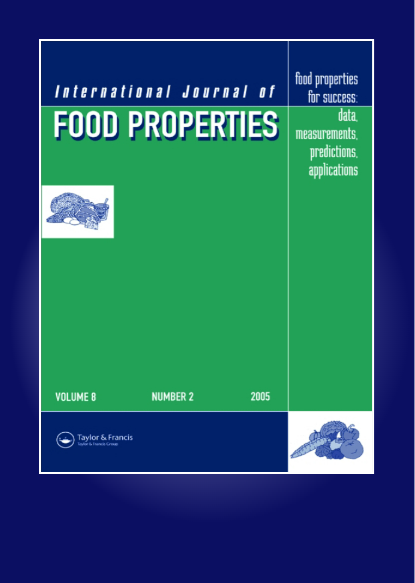Selection of Debaryomyces hansenii isolates to improve quality of dry fermented sausage
IF 3.1
3区 农林科学
Q2 FOOD SCIENCE & TECHNOLOGY
引用次数: 0
Abstract
ABSTRACT The objective of this experiment was to select D. hansenii isolates that are stable in dry fermented sausage (DFS) production and can positively affect the quality. D. hansenii isolates were examined for production of biogenic amines, β-glucuronidase, β-glucosidase, proteolytic, and lipolytic enzymatic activities. The acid and salt tolerance of D. hansenii isolates were also examined. DFS inoculated with selected D. hansenii isolates were analyzed for microorganisms, weight loss, Aw, and pH. DFS was also subjected to analyses of color, texture profile, reducing sugar, volatile basic nitrogen (VBN), lipid oxidation, and free fatty acid. Twenty-two D. hansenii isolates were isolated. None of these D. hansenii isolates produced biogenic amines, and all strains were negative for β-glucuronidase and β-glucosidase activities. After examining these strains for proteolysis, lipolysis, and salt and acid tolerance, D. hansenii isolates SMFM2021-C14, SMFM2021-S8, and SMFM2021-SL3 were selected to be used in DFS. During the processing of DFS, the groups treated with D. hansenii isolate SMFM2021-S8 or SMFM2021-SL3 showed lower (p < .05) hardness values of DFS. The sample treated with D. hansenii SMFM2021-S8 showed lower (p < .05) VBN and lipid oxidation contents than the others. The ratio of ω-6/ω-3 was lower (p < .05) in D. hansenii SMFM2021-SL3 treated group than in the other treatments. These results indicate that D. hansenii isolates SMFM2021-S8 and SMFM2021-SL3 might be useful in producing DFS to improve its quality.提高干发酵香肠品质的汉斯德巴氏菌菌株的筛选
摘要本实验的目的是筛选在干发酵香肠(DFS)生产中稳定并能对质量产生积极影响的汉氏D.hansenii分离株。对汉氏D.hansenii分离株的生物胺、β-葡萄糖醛酸酶、β-葡萄糖苷酶、蛋白水解和脂肪分解酶活性进行了检测。同时还对汉森氏D.hansenii分离株的耐酸性和耐盐性进行了检测。用选定的汉氏D.hansenii分离株接种DFS,对其微生物、体重减轻、Aw和pH进行分析。还对DFS的颜色、质地、还原糖、挥发性碱性氮(VBN)、脂质氧化和游离脂肪酸进行分析。从中分离到22株汉氏D.hansenii菌株。这些D.hansenii分离株均未产生生物胺,所有菌株的β-葡糖苷酸酶和β-葡萄糖苷酶活性均为阴性。在检查了这些菌株的蛋白水解、脂解以及耐盐和耐酸性后,选择了用于DFS的D.hansenii分离株SMFM2021-C14、SMFM2021-S8和SMFM2021-SL3。在DFS处理过程中,用汉氏D.hansenii分离物SMFM2021-S8或SMFM2021-SL3处理的组表现出较低的(p < .05)DFS的硬度值。用D.hansenii SMFM2021-S8处理的样品显示出较低的(p < .05)VBN和脂质氧化含量。ω-6/ω-3比值较低(p < .05)显著高于其它处理。这些结果表明,汉氏D.hansenii分离株SMFM2021-S8和SMFM2021-SL3可能有助于生产DFS以提高其质量。
本文章由计算机程序翻译,如有差异,请以英文原文为准。
求助全文
约1分钟内获得全文
求助全文
来源期刊

International Journal of Food Properties
工程技术-食品科技
CiteScore
5.20
自引率
3.40%
发文量
167
审稿时长
4.3 months
期刊介绍:
The International Journal of Food Properties publishes original research papers devoted to all scientific and applied aspects of food properties. The emphasis is on measurement methods, development of standards, and data on food properties, predictions, and applications.
The International Journal of Food Properties brings together the widely scattered research in the area of food properties and provides an international forum for scientists and technologists for rapid dissemination of their research results, ideas, and knowledge. Other features include review articles, book reviews, letters to the editor, conference papers, news, and commercial advertisements.
 求助内容:
求助内容: 应助结果提醒方式:
应助结果提醒方式:


